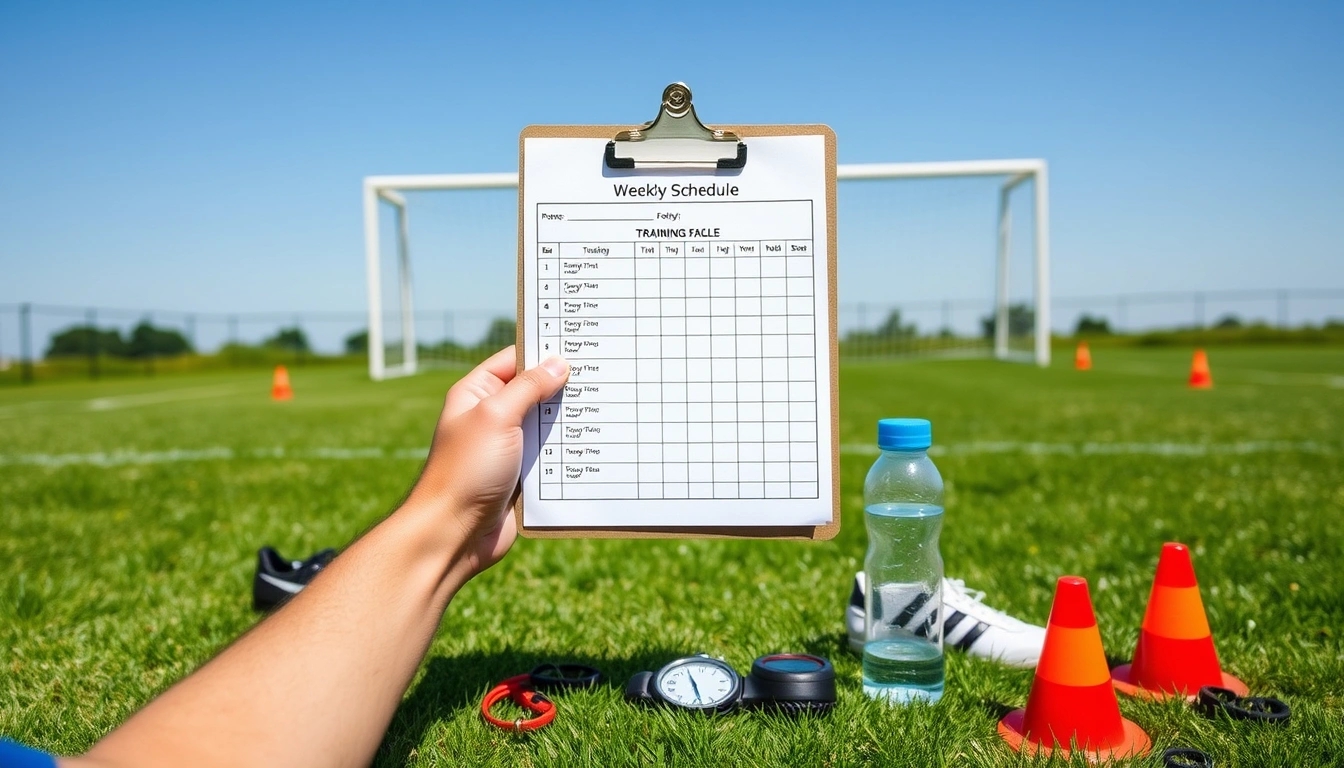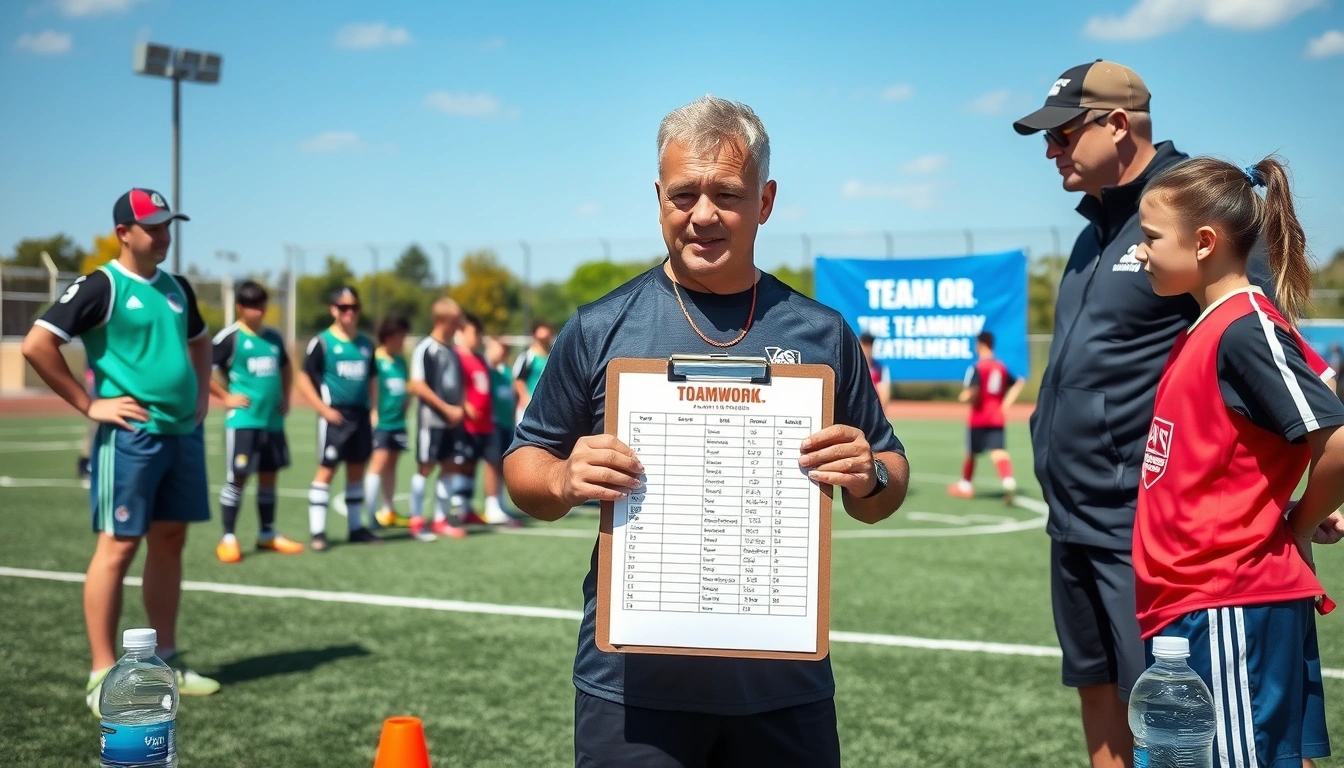Getting youth players ready for the season? Well, it’s no walk in the park. You can’t just throw them on the field and hope for the best. Nope, there’s a whole art and science behind crafting a pre-season training plan that not only sharpens skills but also builds fitness and keeps things fun enough so the kids don’t bail halfway through. Let’s break it down, shall we?
Understanding the Basics of Youth Training
Before you start barking orders or setting up complicated drills, take a step back. Youth training isn’t just mini-adult training. The exercises have to fit their age and development stage. Think of it like this: You wouldn’t expect a 10-year-old to bench press like a pro, right? It’s about coordination, balance, and laying the foundation for future growth. Plus, keeping the sessions fun and engaging is key—if kids dread practice, you’ve lost them. So, age-appropriate, enjoyable, and development-focused: that’s your mantra.
Setting Realistic Goals for Young Athletes
Goal setting can be tricky. You want to push them but not scare them off. The trick is to set achievable, motivating targets that kids can see themselves hitting. Maybe it’s improving their dribbling or running a bit faster. Nothing too lofty like “win the national championship” in pre-season! This keeps the pressure off and lets them enjoy the process.
| Goal Type | Example | Why It Works |
|---|---|---|
| Skill-Based | Complete 20 successful passes in a row | Builds confidence and technique |
| Fitness-Based | Run 1 mile without stopping | Improves endurance gradually |
| Fun-Based | Participate actively in all drills | Keeps motivation high |
Designing a Balanced Weekly Schedule
Now, here’s where some coaches trip up. Too much skill work? Kids get bored. Too much fitness? They get tired or hurt. Rest days? Often overlooked but crucial. A balanced week mixes skill drills, fitness training, and rest. For example:
- Monday: Skill drills focusing on ball control
- Wednesday: Light fitness and conditioning
- Friday: Game simulation and fun activities
- Sunday: Rest and recovery
Incorporating Skill Development Drills
Skill drills are the bread and butter. But kids have short attention spans, so keep drills short, varied, and competitive. Drills like dribbling through cones, passing exercises, or small-sided games work wonders. The key is to make it feel like play rather than punishment.
Fitness and Conditioning Essentials
Conditioning is often seen as “the boring part,” but it’s essential to keep injuries at bay and build stamina. Tailor the fitness routines to their level—think shuttle runs, light sprints, and fun relay races rather than grueling marathon training. And don’t forget warm-ups and cool-downs!
Nutrition Tips for Young Athletes
Fueling up right? Half the battle won. Young athletes need balanced meals with carbs for energy, protein for recovery, and plenty of water. Avoid junk food, but hey, don’t be too strict—kids need to enjoy their food too! A simple tip: pack colorful fruits and veggies in their lunchboxes.
Monitoring Progress and Adjusting Plans
Tracking progress doesn’t mean making kids feel like they’re under a microscope. Keep it light—use fun challenges, simple tests, or even self-assessment. If something’s not clicking, tweak the plan. Flexibility is your friend.
Engaging Parents and Guardians
Parents can be your best allies or your worst critics. Keep them in the loop, encourage their support, and maybe even get them involved in light activities or cheering squads. A little parental enthusiasm goes a long way.
Common Pitfalls and How to Avoid Them
Watch out for burnout, overtraining, or pushing kids too hard too soon. Also, avoid one-size-fits-all plans—every kid is different. Communication and observation are your best tools here.
In conclusion, building a pre-season training plan for youth players is a juggling act. Balance skill, fitness, and fun with a dash of patience and a sprinkle of common sense. Get it right, and you’ll have a team ready to take on the season with smiles and sweat.
Understanding the Basics of Youth Training
Alright, before you jump headfirst into a whirlwind of drills, scrimmages, and endless whistle-blowing, let’s pump the brakes and talk about the real foundation of youth training. It’s not just about running kids ragged or drilling them until they can do a perfect bicycle kick in their sleep. Nope, it’s way more nuanced. The secret sauce? Age-appropriate exercises and clear development goals that actually make sense for young players.
First off, youth training isn’t a one-size-fits-all deal. A 7-year-old’s motor skills and attention span are worlds apart from a 14-year-old’s. So, you gotta tailor the drills to fit their physical and cognitive abilities. For example, little tykes need fun, simple activities that build coordination and basic movement patterns. Throw in some games that sneak in balance and agility without making it feel like a chore. On the flip side, older kids can handle more structured drills that focus on technique and tactical awareness. But don’t get carried away—burnout is real, and nobody wants young athletes quitting before they hit their stride.
- Why age matters: Younger kids thrive on play-based learning, while older ones benefit from targeted skill development.
- Physical growth considerations: Growth spurts can make kids clumsy or prone to injury, so exercises should adapt accordingly.
- Mental readiness: Keeping motivation high means mixing fun with challenge—too much pressure and you lose them.
Now, let’s talk about development goals. Setting them isn’t just ticking boxes on a checklist. It’s about fostering a love for the game, building confidence, and slowly stacking skills over time. Coaches and parents alike should focus on progress, not perfection. For example, a goal for younger players might be simply mastering dribbling with both feet, while older kids might aim to understand positioning or improve stamina.
| Age Group | Training Focus | Example Goals |
|---|---|---|
| 6-9 years | Basic motor skills, fun games, coordination | Learn to dribble, improve balance, enjoy play |
| 10-13 years | Skill development, teamwork, basic tactics | Control ball with both feet, understand positions |
| 14-17 years | Advanced techniques, fitness, tactical awareness | Improve passing accuracy, build endurance |
Remember, it’s not just about physical stuff. Emotional and social growth plays a big role. Kids need encouragement, patience, and a safe space to make mistakes and learn. If you’re a coach or parent, don’t be that person who screams from the sidelines or expects a mini Messi overnight. Instead, be the cheerleader who celebrates small wins and keeps the vibe positive.
In the end, youth training is about laying down a solid, enjoyable foundation that kids can build on season after season. If you nail this part, the drills and schedules will fall into place much easier—and the kids will actually want to keep coming back for more. And isn’t that what we all want? Happy, healthy, and pumped-up young players ready to take on the world (or at least the next game).
Setting Realistic Goals for Young Athletes
When it comes to youth sports, setting goals isn’t just about ticking boxes or chasing trophies. It’s about planting seeds that help young athletes grow, learn, and most importantly, enjoy the game without feeling like they’re drowning in expectations. Now, don’t get me wrong — ambition is great, but setting sky-high targets for kids can backfire faster than you can say “burnout.” So how do coaches and parents strike that sweet spot? Let’s unpack this.
First things first: goals have to be achievable. Sounds obvious, right? But you’d be surprised how often young players get handed goals that are way beyond their current skill level or physical capacity. Imagine telling a 10-year-old to “score 30 goals this season” when they’re still figuring out how to dribble properly. It’s like asking a toddler to run a marathon — cute idea, but not realistic.
- Start small and build up: Break down big ambitions into bite-sized chunks. Instead of “win every match,” try “improve passing accuracy by 10%” or “attend every practice session.” These smaller goals feel doable and keep motivation high.
- Focus on effort, not just outcomes: Teach kids to value hard work and progress over just winning. Reward hustle, teamwork, and attitude — these are the real building blocks.
- Make goals personal: Each player is different. What fires up one kid might bore another. Chat with them, understand what excites them about the sport, and tailor goals accordingly.
| Goal Type | Example | Why It Works |
|---|---|---|
| Skill-Based | Complete 20 accurate passes in practice | Clear, measurable, and focused on improvement |
| Effort-Based | Attend all training sessions this month | Encourages consistency and commitment |
| Attitude-Based | Support teammates during games | Builds team spirit and positive mindset |
Now, here’s where many coaches trip up: overloading young minds with too many goals at once. It’s tempting to cram every possible target into a season plan, but that just leads to confusion and frustration. Imagine juggling five balls while riding a bike — possible for circus pros, not so much for kids still learning the basics. Stick to two or three key goals per player and review them regularly. Flexibility is key; if a goal feels like a mountain, it’s okay to adjust the slope.
Also, don’t forget to sprinkle in some fun. Goals should challenge, sure, but they shouldn’t suck the joy out of playing. Celebrate small wins loudly — maybe a high-five, a shoutout, or even a goofy dance. Positive reinforcement keeps young athletes coming back for more.
In summary: Setting realistic goals for youth athletes is a balancing act between challenge and achievability. Keep targets clear, personalized, and limited in number. Focus on effort and attitude as much as results. And above all, keep it fun — because if the kids aren’t enjoying themselves, what’s the point?
Remember, the ultimate goal here isn’t just winning games; it’s nurturing confident, skilled, and happy players who want to keep playing long after the season ends.

Designing a Balanced Weekly Schedule
Creating a weekly training plan for youth players isn’t just about cramming in as many drills and runs as possible. Nope, it’s a delicate dance between skill-building, fitness, and—believe it or not—rest. You might be thinking, “Rest? But we gotta push ‘em hard!” Well, hold your horses. Overdoing it can backfire big time, leading to burnout or injuries. So, how do you juggle these elements without losing your mind or the kids’ enthusiasm? Let’s break it down.
Skill Work: The Core of Every Session
Skill drills are the bread and butter of pre-season training. But here’s the catch: young players have short attention spans and zero patience for boring repetitions. Mix it up! Incorporate fun, game-like drills that improve ball control, passing accuracy, and tactical awareness. For example, a simple passing relay race or small-sided games can do wonders. Aim for about 3-4 skill sessions per week—enough to keep progress steady without overwhelming them.
Fitness and Conditioning: Not Just Running Laps
Conditioning is often misunderstood. It’s not about making kids run until they drop. Instead, focus on age-appropriate exercises that build endurance, agility, and strength. Think short sprints, shuttle runs, and bodyweight exercises like squats or lunges. Two to three sessions a week should suffice. Remember, the goal is to boost fitness without making them dread training.
| Day | Focus | Notes |
|---|---|---|
| Monday | Skill Development | Drills + small-sided games |
| Tuesday | Fitness & Conditioning | Agility & endurance exercises |
| Wednesday | Rest / Light Recovery | Stretching, foam rolling |
| Thursday | Skill Development | Ball control + passing drills |
| Friday | Fitness & Conditioning | Strength & sprint work |
| Saturday | Mixed Session | Fun games + tactical play |
| Sunday | Full Rest | Relax and recharge |
Rest and Recovery: The Unsung Heroes
Don’t skip this part, seriously. Kids’ bodies are still growing, so recovery days aren’t just a luxury—they’re a necessity. Use rest days for light activities like stretching or yoga, and encourage plenty of sleep. Without proper recovery, all those hard-earned gains can vanish faster than you can say “injury.”
- Tip #1: Keep an eye on how the kids feel. If they’re dragging or cranky, it might be time to dial back.
- Tip #2: Hydration and nutrition are key. A tired player is often just a hungry or dehydrated player.
- Tip #3: Be flexible. Sometimes, the plan needs tweaking—don’t be afraid to adjust on the fly.
So there you have it—a realistic, balanced weekly schedule that respects the young athlete’s needs while pushing them just enough to improve. Remember, the goal is progress, not perfection. Keep it fun, keep it varied, and watch those kids thrive.
Incorporating Skill Development Drills
When it comes to pre-season training for youth players, skill drills are absolutely the core of the whole operation. Forget about just running laps or endless sprints — the real magic happens when kids get their hands (or feet) on exercises that sharpen their technique while keeping the fun alive. Let’s be honest, if the drills are boring, you might as well be asking them to watch paint dry. So, how do you strike that perfect balance between serious skill-building and keeping the kiddos pumped up?
First off, it’s essential to understand that youth athletes aren’t mini-professionals yet. Their attention spans are shorter than a TikTok video, and their coordination is still a work in progress. That means drills need to be simple, repetitive, but with a twist of challenge. Think of it as teaching them the ABCs of their sport but with a splash of creativity. For example, instead of just passing drills, why not turn it into a game where they earn points for accuracy or speed?
- Drill 1: Cone Weaving – Set up cones and have players dribble or run through them. It sharpens agility and ball control. Make it a race or a timed challenge to add excitement.
- Drill 2: Passing Circles – Players form a circle and pass the ball quickly around. Add a rule where if someone drops it, the whole circle does a fun penalty like jumping jacks.
- Drill 3: Target Shooting – Place targets on the goal or wall and have kids aim for them. Keeps shooting practice engaging and goal-oriented.
| Drill Name | Purpose | Engagement Tip |
|---|---|---|
| Cone Weaving | Improves agility & ball control | Turn it into a timed race |
| Passing Circles | Enhances passing accuracy & teamwork | Add fun group penalties |
| Target Shooting | Sharpens shooting precision | Use colorful targets & scoring |
Now, here’s the kicker — kids love variety. If you keep hammering the same drill over and over, they’ll start to zone out or, worse, dread practice. So mixing up drills, switching the pace, and throwing in some unexpected challenges keeps their brains and bodies on their toes. Plus, when they see progress, even tiny wins, their confidence skyrockets. And confidence? That’s the secret sauce for any young athlete.
Another thing to keep in mind: drills shouldn’t just be about individual skill. Team dynamics matter too. Incorporate exercises that require communication, quick thinking, and cooperation. For instance, small-sided games or relay races can be fantastic for blending skill development with social interaction.
Sample Weekly Skill Drill Plan:Monday:- Cone Weaving (15 mins)- Passing Circles (15 mins)- Cool down & fun game (10 mins)
Wednesday:- Target Shooting (20 mins)- Small-sided scrimmage (20 mins)- Stretch & talk (10 mins)
Friday:- Relay Races with ball control (15 mins)- Passing under pressure drills (20 mins)- Team cheer & review (10 mins)
Lastly, don’t forget the power of encouragement. Kids feed off the energy you bring. Celebrate their efforts, laugh off the mistakes, and keep the atmosphere light. Because at the end of the day, pre-season skill drills are about building a foundation — not just for the game, but for a lifelong love of sport. And if you can sneak in some laughs and cheers along the way, you’re doing it right.
Fitness and Conditioning Essentials
Fitness and Conditioning Essentials for Youth Players
When we talk about conditioning, most folks immediately picture grueling workouts reserved for professional athletes. But let’s get real — youth players absolutely need their own version of conditioning, tailored just for them. It’s not about pushing kids to the brink; instead, it’s about helping them build a solid foundation of endurance, strength, and injury prevention that will serve them well all season long.
Why Conditioning Matters for Young Athletes
Conditioning isn’t just some fancy buzzword coaches throw around. For youth players, it’s the secret sauce that keeps them on the field and out of the doctor’s office. Young bodies are still developing, which means they’re more prone to injuries if they jump straight into intense physical activity without proper preparation. A well-designed conditioning routine boosts cardiovascular health, improves muscle strength, and enhances flexibility — all of which reduce the risk of strains, sprains, and overuse injuries.
- Endurance Building: Kids can’t just sprint endlessly without gasping for air. Gradual aerobic exercises like jogging, cycling, or swimming help build stamina over time.
- Strength Training: No, this doesn’t mean lifting heavy weights. Bodyweight exercises such as squats, lunges, and push-ups are perfect for developing functional strength.
- Flexibility and Mobility: Stretching routines and dynamic warm-ups keep muscles limber and joints healthy.
Creating Age-Appropriate Conditioning Plans
One size definitely does not fit all when it comes to conditioning young athletes. A 10-year-old’s routine should look very different from that of a 16-year-old. Younger kids benefit from shorter, varied sessions that mix fun with fitness — think relay races or obstacle courses — while older youth players can handle more structured workouts focusing on specific fitness components.
| Age Group | Focus Areas | Sample Activities |
|---|---|---|
| 6-10 years | Basic movement, fun endurance | Tag games, short sprints, jumping jacks |
| 11-13 years | Endurance, strength, flexibility | Jogging, bodyweight exercises, dynamic stretching |
| 14-18 years | Targeted conditioning, injury prevention | Interval training, resistance bands, yoga |
Practical Tips to Keep Conditioning Engaging
Let’s be honest — kids can get bored fast. So, mixing up conditioning exercises with games and challenges is a must. Coach creativity here can make or break the routine. For example, instead of just running laps, turn it into a scavenger hunt or a relay race. Add some friendly competition or teamwork elements to keep spirits high.
Also, don’t forget the magic of rest days. Conditioning doesn’t mean non-stop training. Recovery is where muscles rebuild stronger and young athletes avoid burnout. Balance is king.
In a nutshell: Conditioning for youth players is about smart, fun, and safe fitness routines that build endurance and keep injuries at bay. It’s not rocket science, but it does require a thoughtful approach that respects the unique needs of growing bodies. So next time you hear “conditioning,” don’t cringe — think of it as the secret weapon to a winning season.
Nutrition Tips for Young Athletes
Alright, let’s get real about nutrition for young athletes gearing up for the pre-season grind. Fueling the body right isn’t just some fancy jargon coaches throw around to sound smart — it’s actually half the battle when it comes to energy, recovery, and overall performance. You can have the best drills, the most motivated kids, but if their plates aren’t stacked with the right stuff, well, good luck keeping them on their toes.
First off, simplicity is key. We’re not talking about turning these youngsters into nutrition experts overnight or forcing kale smoothies down their throats. Nope. The goal here is to support their growing bodies and keep their energy levels steady throughout those tough practice sessions. Think of it like this: a well-fed athlete is a happy athlete — less cranky, more focused, and way less likely to be grabbing for the nearest bag of chips mid-training.
- Carbs are your friend: These bad boys provide the quick energy needed for drills and scrimmages. Whole grains, fruits, and veggies should be the go-to sources.
- Protein for repair: After all that running around, muscles need some TLC. Lean meats, dairy, beans, or nuts are perfect picks.
- Hydration isn’t optional: Water is like the unsung hero here. Dehydration can tank performance faster than you’d think.
Now, here’s a quick table to break down a simple pre-season nutrition plan for a typical day:
| Meal | Recommended Foods | Purpose |
|---|---|---|
| Breakfast | Oatmeal with fruit, scrambled eggs | Provides sustained energy and protein for muscle support |
| Snack (Pre-practice) | Banana, yogurt | Quick energy boost without feeling heavy |
| Post-practice Snack | Chocolate milk or peanut butter sandwich | Replenishes glycogen and aids muscle recovery |
| Dinner | Grilled chicken, brown rice, steamed veggies | Balanced meal for recovery and energy restoration |
Let’s not forget, though, that young athletes are kids first and sometimes picky eaters second. Forcing them to eat like mini bodybuilders can backfire spectacularly. Instead, encourage variety and let them get involved in meal prep — it’s amazing how a kid suddenly loves broccoli when they helped cook it. Also, watch out for the sneaky sugar monsters hiding in sports drinks and energy bars. Sure, they sound like a quick fix, but often they just lead to energy crashes and crankiness.
Recovery is another piece of the puzzle. After intense sessions, the body screams for nutrients to rebuild and recharge. That’s why post-practice snacks rich in carbs and protein are non-negotiable. And no, a candy bar doesn’t count just because it has sugar. Aim for wholesome options that actually help rather than hinder progress.
- Encourage kids to listen to their hunger cues — eating when hungry, stopping when full.
- Make hydration fun — flavored water with a splash of juice can do wonders.
- Remind parents and coaches that nutrition is a team effort — it’s about creating habits, not perfection.
In the end, it’s about balance and consistency. Young athletes don’t need complicated diets, just simple, smart choices that keep them energized and ready to tackle the pre-season head-on. Because let’s face it — no one wants a bunch of hangry kids on the field, right?
Monitoring Progress and Adjusting Plans
When it comes to youth sports, keeping an eye on how players are improving is absolutely vital. You can’t just set a plan and hope for the best — things change, kids grow, and what worked last week might flop the next. So, tracking progress isn’t some boring chore; it’s the secret sauce that keeps the whole pre-season training plan fresh and effective.
First off, how do you even keep track without turning into a full-time data analyst? Easy: use simple, practical methods that fit into your routine. For example, a weekly skills checklist can work wonders. List key drills or skills you want the players to improve — dribbling speed, passing accuracy, or stamina tests — and tick off what’s getting better (or worse, because hey, that happens too). This kind of visual progress chart not only helps coaches but also motivates the kids when they see their own improvements.
| Skill Area | Measurement | Frequency | Notes |
|---|---|---|---|
| Dribbling | Time to complete obstacle course | Weekly | Track time improvements |
| Passing Accuracy | Number of successful passes in 1 minute | Bi-weekly | Focus on technique |
| Endurance | Distance run in 12 minutes | Monthly | Watch for fatigue signs |
Now, the real trick is adjusting the plan based on what you find. If a player is crushing a skill faster than expected, maybe it’s time to throw in some more challenging drills or speed up the pace. On the other hand, if progress stalls or a kid looks burnt out, it’s a signal to dial back, add extra rest, or switch up the activities. Flexibility is key here — don’t be that coach who sticks rigidly to a plan just because it’s “the plan.”
- Use feedback from players: Ask them what’s fun, what’s tough, or what they want more of.
- Keep an eye on physical and mental signs: Tired eyes, lack of enthusiasm, or frequent injuries are red flags.
- Celebrate small wins: Progress isn’t always about big leaps; sometimes it’s those tiny improvements that keep motivation alive.
One practical tip? Keep a simple journal or digital log for each player. It doesn’t have to be fancy — a quick note about what worked, what didn’t, and any changes made can save you headaches later. Plus, it’s a handy tool when you chat with parents or guardians about their child’s development.
Remember, the goal isn’t just to make kids better athletes, but to keep them loving the game. Monitoring progress and tweaking the plan is less about perfection and more about staying connected — to the players, their needs, and the unpredictable nature of youth sports. So, embrace the messiness, stay flexible, and keep pushing forward.
In summary:
- Track progress with simple, regular assessments.
- Adjust training based on results and player feedback.
- Watch out for signs of burnout or frustration.
- Keep records to guide future decisions.
- Celebrate every step forward — no matter how small.
That’s how you keep the momentum going and make sure your pre-season plan isn’t just a static document gathering dust but a living, breathing guide that grows with your young athletes.

Engaging Parents and Guardians
When it comes to youth sports, parents aren’t just spectators on the sidelines—they’re the secret sauce that can either spice up the whole training experience or leave it flat and flavorless. Seriously, their involvement can make or break a young athlete’s motivation and overall development. But how do you get them on board without turning every practice into a parent-teacher conference? It’s a bit of a tightrope walk, but totally doable.
First off, communication is king. Coaches need to keep parents in the loop—not just with schedules and game times, but with the why behind training drills and goals. When parents understand the purpose, they’re more likely to cheer on rather than nag. A quick weekly email or a group chat update can work wonders. Throw in some progress highlights or funny moments from practice to keep it light and relatable. Nobody wants to read a dry report that feels like a homework assignment.
- Tip 1: Host a pre-season meeting to outline expectations and answer questions.
- Tip 2: Share simple ways parents can support at home, like encouraging proper rest and nutrition.
- Tip 3: Create a volunteer schedule so parents feel involved but not overwhelmed.
Now, here’s where it gets tricky: balancing enthusiasm with pressure. Some parents go full “coach mode” from the stands, which can be a total buzzkill for kids. Setting clear boundaries helps. Explain that while encouragement is awesome, constant criticism or coaching from the sidelines can mess with a player’s confidence. Believe me, kids notice when mom or dad’s voice drowns out the coach’s instructions.
| Positive Parental Involvement | Negative Parental Involvement |
|---|---|
| Cheering and encouraging effort | Yelling instructions during play |
| Helping with logistics (rides, snacks) | Putting too much emphasis on winning |
| Supporting healthy habits at home | Criticizing mistakes publicly |
| Volunteering for team activities | Over-scheduling or burnout pressure |
And hey, don’t forget the power of positivity! Recognizing parents for their support—whether it’s a shout-out at practice or a thank-you note—can build a community vibe that everyone wants to be part of. When parents feel appreciated, they’re more likely to stick around and keep the good energy flowing.
In the end, it’s all about teamwork—not just on the field but off it too. When coaches and parents join forces with clear communication, mutual respect, and a shared goal of nurturing young athletes, the whole pre-season experience becomes way more rewarding. So, yeah, parents are a big deal. But with the right approach, they can be your best allies instead of your biggest headaches.
Quick Checklist for Coaches:
- Set clear expectations early
- Keep communication consistent and friendly
- Encourage positive sideline behavior
- Invite parents to be part of the journey, not just spectators
- Celebrate small wins together
Bottom line? Parents aren’t just there to watch—they’re part of the team. Treat them like it, and you’ll see the difference in your young players’ smiles and skills.
Common Pitfalls and How to Avoid Them
Alright, let’s be real—pre-season training for youth players isn’t always a walk in the park. Coaches, even the most seasoned ones, tend to stumble into a few classic traps that can throw a wrench in the whole process. So, here’s a friendly heads-up on some typical mistakes and how you can dodge them like a pro.
- Overloading Young Athletes: It’s tempting to cram every drill, fitness session, and scrimmage into the schedule, thinking more is better. Spoiler alert: it’s not. Kids need time to rest and recover, or else you’re looking at burnout city. Instead, aim for quality over quantity. Short, focused sessions with plenty of breaks work wonders.
- Ignoring Individual Differences: Not every player develops at the same pace. Some kids might be sprinting ahead in skills, while others are still figuring out the basics. A one-size-fits-all approach? Big no-no. Tailor your drills and expectations to fit each player’s unique needs.
- Neglecting Fun: If training feels like a chore, good luck keeping the kids motivated. Remember, these are young players, not robots. Inject some games, challenges, and light-hearted moments to keep spirits high and energy up.
Now, here’s a quick table to sum up the pitfalls and smart fixes:
| Common Mistake | Why It’s a Problem | How to Avoid It |
|---|---|---|
| Overtraining | Leads to fatigue, injuries, and loss of enthusiasm | Schedule rest days and focus on shorter, quality sessions |
| One-Size-Fits-All Coaching | Some players feel left behind or bored | Customize drills and goals based on individual progress |
| Forgetting the Fun Factor | Kids lose interest and motivation drops | Include playful activities and celebrate small wins |
Another sneaky pitfall? Communication breakdown. Coaches sometimes forget to keep parents and players in the loop, which can cause confusion or frustration. Pro tip: set up regular check-ins or quick updates, even if it’s just a group chat message. Transparency builds trust and keeps everyone rowing in the same direction.
Also, don’t shy away from adjusting your plan mid-way. Sometimes what looks good on paper doesn’t fly on the field. Be ready to tweak drills, change intensity, or even swap out activities if something isn’t clicking. Flexibility is your best friend here.
Finally, watch out for the trap of perfectionism. Expecting flawless execution from young players is a recipe for frustration—for both coach and kids. Embrace mistakes as part of learning. After all, pre-season is about growth, not gold medals.
To wrap it up, here’s a quick checklist to keep handy:
- Plan balanced sessions with rest
- Know your players’ individual needs
- Keep training fun and engaging
- Communicate openly with parents and players
- Stay flexible and ready to adapt
- Celebrate progress, not perfection
So yeah, pre-season won’t be flawless, but with a bit of awareness and a lot of patience, you’ll steer clear of these common pitfalls and set your youth players up for a smashing season ahead.
Frequently Asked Questions (The title must be written in English.)
- Why is a pre-season training plan important for youth players?
Think of pre-season training as the foundation of a house. Without a solid base, everything else can crumble! It prepares young athletes physically and mentally, helping them build skills, improve fitness, and avoid injuries before the competitive season kicks off. Plus, it sets the tone for a fun and productive year ahead.
- How do I set realistic goals for young athletes?
Setting goals is like plotting a road trip—you want achievable milestones, not impossible destinations. Focus on specific, measurable, and age-appropriate targets that encourage progress without pressure. For example, improving ball control or increasing stamina gradually keeps motivation high and frustration low.
- What should a balanced weekly training schedule look like?
Imagine juggling balls—you need to keep all of them in the air without dropping any. A balanced schedule blends skill drills, fitness training, rest days, and recovery. This mix helps players develop holistically while preventing burnout. Don’t forget to sprinkle in fun activities to keep the energy buzzing!
- Which skill development drills are best for youth players?
Drills that feel like games are golden! Focus on exercises that improve fundamental techniques—like dribbling, passing, and shooting—while keeping things lively. Short, varied drills prevent boredom and help young athletes stay engaged and eager to learn.
- How can I ensure youth players stay injury-free during pre-season?
Think of injury prevention as wearing a seatbelt—it’s essential. Incorporate proper warm-ups, cool-downs, and conditioning tailored to young bodies. Emphasize correct technique and listen to players’ feedback to avoid overtraining or pushing too hard too soon.
- What nutrition tips support young athletes during training?
Fueling young players is like charging a battery—without the right energy, performance dips. Encourage balanced meals rich in proteins, carbs, and healthy fats, along with plenty of hydration. Simple snacks like fruits and nuts before and after training can boost energy and aid recovery.
- How do I monitor progress and adjust the training plan?
Tracking progress is like checking your GPS on a trip—you want to know if you’re on the right path. Use simple tools like performance logs, feedback sessions, and video analysis to see improvements and spot areas needing tweaks. Flexibility in the plan keeps players growing steadily.
- What role should parents and guardians play in pre-season training?
Parents are the co-pilots on this journey. Their support, encouragement, and understanding can boost young athletes’ confidence and commitment. Keep communication open and involve them in nutrition, rest, and motivation to create a positive training environment.
- What common mistakes should coaches avoid during pre-season?
Trying to sprint before walking can backfire. Avoid overloading players with too much intensity or complex drills too soon. Also, don’t neglect rest or ignore individual needs. A flexible, player-focused approach prevents burnout and keeps the training explosive and exciting.












